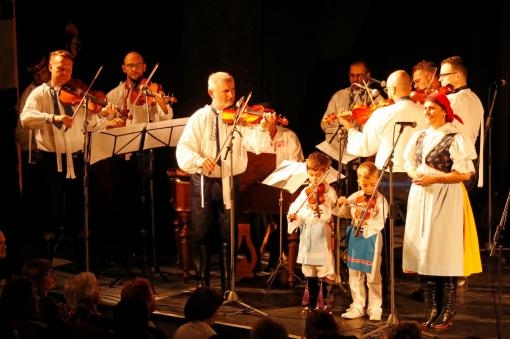Two sold-out concerts launched on Saturday filled-up the hall of the Koruna cinema in Břeclav, where the Národopisný soubor Břeclavan [Břeclavan Ethnographic Ensemble] celebrated its 65th anniversary and joined thus the series of jubilee folklore ensembles this year. The afternoon concert had to be eventually added because of the huge audience acclaim, which only confirms that in South Moravia folklore is still widely known and enjoys unremitting popularity.
Břeclavan was founded in 1954 by a doctor, violinist and an unforgettable personality of Moravian folklore Jožka Kobzík. Subsequently, for several decades he was the leader of the ensemble, compiled several pieces of choreography and created his own distinctive folkloristic style and character, which the dancers and musicians have been trying to maintain to this day.
The entire anniversary programme was conceived very traditionally. Although I do not consider myself a traditionalist, I was pleased. In a flood of folklore experiments, which have recently emerged as mushrooms after the rain (and in many cases very successful, I do not want to damn them in any way), this performance was not conceptually oversaturated. The artists tried their best to give the audience pure joy.
Each of the numbers was presented by speakers. Stanislav Strmiska and Jiří Mach, former members of Břeclavan, took on this task with their typical humour.
Although the ensemble has never really devoted itself exclusively to the home region of Podluží, I was surprised that it was only represented by two dances. As always, Jiljí Herzán and Zuzana Martinková were excellent in singing songs from the mentioned region. Břeclavan has for many years set out from the flatlands of Podluží on imaginary hikes to the mountainous areas of Kopanice, both the Moravian and the Slovak ones in the vicinity of the town of Myjava. Dances from both regions also appeared at this anniversary celebration.
The dancers have maintained excellent standards for several generations now. At the Saturday concert I had the impression that the male part of the ensemble is a little better technically equipped than the female. Many years of good dancing training showed out clearly at the premiere performance of FS BŘUCH (read: Břeclavan's artistic pack). This "outgrown" part of the ensemble was featured in a successful choreography called Poštoranky to sú Anky.
In any case, I must not forget to mention DFS Břeclavánek. It is the girl's part of the children's ensemble with a “small” band that excelled as Starobřeclavské pradlenky. They showed an inventive use of props, rhythmic plays, singing and dancing in a truly successful way.
The male dance, or rather a dancing game called Širákový z Myjavy is very popular. I have seen it in performed by many ensembles by now. Břeclavan's version of the dance, written by leading dancer Libor Stránský, surpassed many previous performances with its wit and quality.
The final dance from the currently very popular Slovak-Hungarian border was proof that the Břeclavan dancers are masters of verbuňk [recruitment dance] across the regions, even though I personally missed the classical solo one from Podluží at the anniversary celebration. I wish Břeclavan a lot of energy and new ideas in the years to come and thank them for a very pleasant evening in their company.
































No comment added yet..